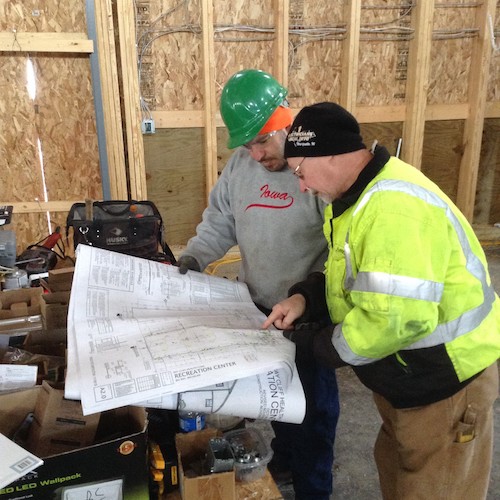
|
| Upper Peninsula Local 906 Business Manager Tom Hogan, right, works with a local high school student during a building skills competition.
|
About 310,000 people live in
Michigan’s Upper Peninsula, spread out over more than 16,000 square miles –
making it geographically larger than nine states. Outside of driving for several
hours through three other states, one could reach the rest of Michigan only by air
or ferry until 1957, when the five-mile Mackinac Bridge was opened.
Longtime residents say that fostered a spirit of looking out for each other. Upper Peninsula Local 906 Business Manager Tom Hogan saw it firsthand while growing up. It was reinforced during his apprenticeship in the early 1970s with Marquette, Mich., Local 1070, where he was told volunteering your time and skills was expected.
“I was raised that way,” he said. “When I was an apprentice, I was taught that. You give back to the community.”
Local 1070 and two other local unions merged in 2016 to form 906. The spirit of volunteerism lives on in Hogan and the rest of his 350 members.
Apprentices perform regular maintenance work on a local woman’s shelter, including installing new light fixtures last December. Members constructed a covered pavilion at Michigan Tech’s football stadium so disabled fans could see games sheltered from the weather. They maintain a playground for children on Marquette’s public beach, all on a volunteer basis.
“It’s being part of the Brotherhood and helping each other out,” said Local 906 organizer Kurtis Monroe, who completed his apprenticeship last year.
For the last 30 years, Local 906 members and their predecessors have volunteered to maintain the facilities at Bay Cliff Health Camp. It has hosted a summer camp for children with physical disabilities between the ages of 4 and 16 since 1934.

|
| Upper Peninsula apprentices at work last winter on the Women’s Center in Marquette, Mich. The center aids victims of domestic violence.
|
“Whenever we have a facility issue, Tom addresses the electrical for us,” said camp director Tim Bennett, who has known Hogan for more than 50 years. “He has the journeymen and apprentices coming in.”
Hogan makes it clear to apprentices and members they are expected to take part in community service. He was Local 1070’s business manager from 1986-2000, serving in a variety of leadership positions after that, including president, before returning to serve as business manager in 2013, overseeing the merger.
“Many years ago, the IBEW was known as the union of hearts and minds,” Hogan said. “We took that and have hung onto that motto, if you will.”
Former Local 1070 Business Manager Tony Retaskie, who is now head of the Upper Peninsula Construction Council, agreed that the tradition of IBEW members volunteering in the area runs deep. It started several generations ago and encouraged other trades to step up as well.
“Now, I think it’s more of a mantra,” Retaskie said.
Hogan said an apprentice’s commitment to community service also is a good indication if he or she might be a future leader.
Monroe is a member of the Sault Tribe of Chippewa Indians and lives in Sault Ste. Marie, Mich., the tribe's ancestral home and a three-hour drive from Marquette. Hogan notes with pride Monroe made that drive many Saturdays to help with projects at Bay Cliff.
“If you’re going to be a leader in the IBEW,” Hogan said, “there’s no such thing as a 40-hour week.”
Along the way, Hogan and others have built a wealth of friendship and gratitude that symbolizes the best of the Upper Peninsula. Bennett said he sees the payoff every day at Bay Cliff.
“We’re not a government program,” he said. “Our annual budget is $1.5 million. We have many programs during the year and 130 staffers during the summer. There’s not a lot left to take care of all these buildings.